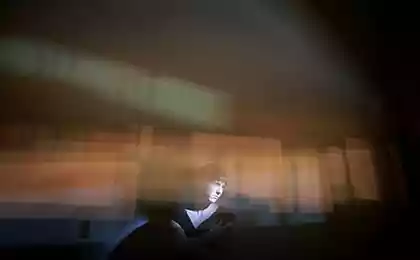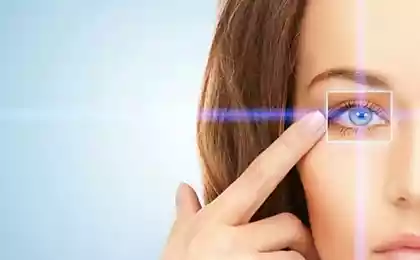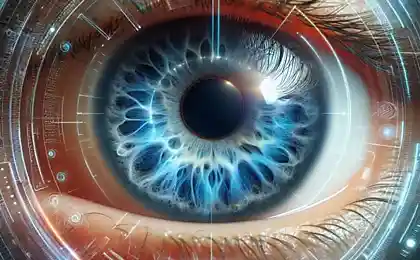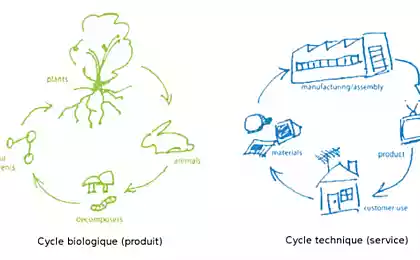1068
A new way to enhance night vision
was tested in humans.

Patent of 2012, based on the work [4], described a little different use of chlorine e6 (hereinafter Ce6): a drug used to фотодинамической therapy of cancer, was supposed to enter the eye, blending with insulin or dimethyl sulfoxide for better absorption by the retina.
Ce6 - analog of chlorophyll. Under the influence of light radiation (PDT lasers are used) it allocates активные oxygen species , actually kill cancer cells. That, of course, has raised fears of irreversible damage to the introduction of the substance in his eyes.
The combination of insulin and DMSO used in the experiment to enhance absorption Ce6 retina. Obtained from these substances and weak water solution of NaCl mixture was black and kept wrapped in foil (probably to avoid light exposure) at 20 ° C.
After the preparation of the test to experiment with a pipette in his konyunktivialnye bags (roughly speaking, under the eyelids) entered small doses of the mixture, making sure the fact that it was not included in the nasopharynx, with its absorption is fast enough: black dissipated in seconds. Then the subject is established black contact lenses (they can be seen on KDPV) and put on sunglasses to reduce the amount of light entering the eye. Further points were taken only during the tests. (Lenses were allegedly removed before them and no longer used.)
The effect of the mixture became visible after one hour after its application [3]. After a two-hour adaptation began testing. Test and four people representing a control group, resulted in a darkened place, where they were at a distance of 10 meters recognize different objects with marks on them in the form of numbers, letters and geometric symbols.
The experiment was then continued in the grove where a group of people were asked to stand up in the trees and bushes so as to be at a distance of 25 to 50 meters to the point where the test and control group tried to identify them visually and by means of a laser pointer to note their position.
During the test subject correctly identified objects in 100% of cases, and the control group - only 33%. After the test, he put on his sunglasses and did not remove them before going to bed, in the morning as his vision returned to normal, and at least 20 days after the experiment had no significant deviations from it.
[3] - Shantha, T, inventor, assignee. Methods to Enhance Night Vision and Treatment of Night Blindness. 21 June 2012. Patent 20120157377.
[4] - Washington I, Zhou J, Jockush S, Turro N, Nakanishi K, Sparrow J. Chlorophyll Derivatives as a Visual Pigment for Super Vision in the Red. Photochem. Photobiol., 2007, 6: 775-779, DOI: 10.1039 / b618104j i>
Note .: study is a continuation of another, described in [4], but the study can be called a stretch of just one subject and the small size of the control group. Unlike human mixture was injected intravenously into mice and the results obtained using electroretinography. Mechanism of action Ce6 publication is not described, and it was carried out to test the effects of chlorophyll on vision in the red region of the spectrum in mammals after they were found in the bodies of a number of other animals, including amphibians and deep-sea fish.
Source: geektimes.ru/post/248012/

Patent of 2012, based on the work [4], described a little different use of chlorine e6 (hereinafter Ce6): a drug used to фотодинамической therapy of cancer, was supposed to enter the eye, blending with insulin or dimethyl sulfoxide for better absorption by the retina.
Ce6 - analog of chlorophyll. Under the influence of light radiation (PDT lasers are used) it allocates активные oxygen species , actually kill cancer cells. That, of course, has raised fears of irreversible damage to the introduction of the substance in his eyes.
The combination of insulin and DMSO used in the experiment to enhance absorption Ce6 retina. Obtained from these substances and weak water solution of NaCl mixture was black and kept wrapped in foil (probably to avoid light exposure) at 20 ° C.
After the preparation of the test to experiment with a pipette in his konyunktivialnye bags (roughly speaking, under the eyelids) entered small doses of the mixture, making sure the fact that it was not included in the nasopharynx, with its absorption is fast enough: black dissipated in seconds. Then the subject is established black contact lenses (they can be seen on KDPV) and put on sunglasses to reduce the amount of light entering the eye. Further points were taken only during the tests. (Lenses were allegedly removed before them and no longer used.)
The effect of the mixture became visible after one hour after its application [3]. After a two-hour adaptation began testing. Test and four people representing a control group, resulted in a darkened place, where they were at a distance of 10 meters recognize different objects with marks on them in the form of numbers, letters and geometric symbols.
The experiment was then continued in the grove where a group of people were asked to stand up in the trees and bushes so as to be at a distance of 25 to 50 meters to the point where the test and control group tried to identify them visually and by means of a laser pointer to note their position.
During the test subject correctly identified objects in 100% of cases, and the control group - only 33%. After the test, he put on his sunglasses and did not remove them before going to bed, in the morning as his vision returned to normal, and at least 20 days after the experiment had no significant deviations from it.
[3] - Shantha, T, inventor, assignee. Methods to Enhance Night Vision and Treatment of Night Blindness. 21 June 2012. Patent 20120157377.
[4] - Washington I, Zhou J, Jockush S, Turro N, Nakanishi K, Sparrow J. Chlorophyll Derivatives as a Visual Pigment for Super Vision in the Red. Photochem. Photobiol., 2007, 6: 775-779, DOI: 10.1039 / b618104j i>
Note .: study is a continuation of another, described in [4], but the study can be called a stretch of just one subject and the small size of the control group. Unlike human mixture was injected intravenously into mice and the results obtained using electroretinography. Mechanism of action Ce6 publication is not described, and it was carried out to test the effects of chlorophyll on vision in the red region of the spectrum in mammals after they were found in the bodies of a number of other animals, including amphibians and deep-sea fish.
Source: geektimes.ru/post/248012/
FTC offers open access to military frequencies for civilian use
Google quietly launched a service data compression for the desktop version of Chrome






















